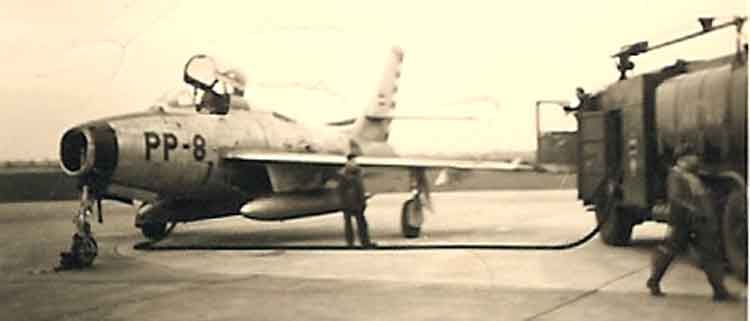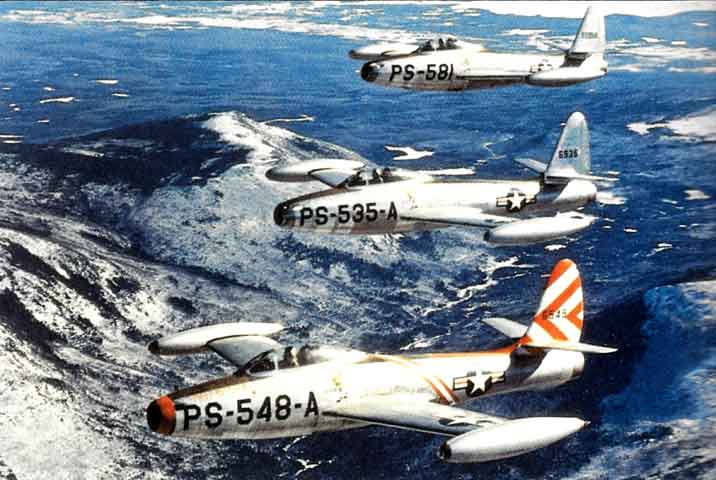
|
|
Republic F-84F Thunderstreak being refueled at Jever - about 1956. Republic F-84F Thunderstreak The swept-wing Republic XF-84F Thunderstreak, which utilised about 60 per cent of the F-84's components, flew for the first time on 3Jun50, only 167 days after it was ordered. The first production F-84F flew on 22Nov52, and the type was officially accepted by the US Air Force in the following month. The first US Air Force unit to arm with the F-84F, in 1954, was the 407th Tactical Fighter Wing. The F-84F replaced the Republic F-84 Thunderjet in several NATO air forces, giving many European pilots their first experience of modern swept-wing jet aircraft, the aircraft saw action during the 1956 Anglo-French operation to secure the Suez Canal, flying from a base in Israel to destroy a number of Egyptian Il-28 jet bombers that had been evacuated to Luxor. The Republic RF-84F Thunderflash was a low-level tactical reconnaissance variant. Crew: 1; Powerplant: one 3,278Kg (7,220lb) thrust Wright J65-W-3 turbojet engine; Performance: Max speed 1,118km/hr (695mph); Combat radius: 1,304km (810 miles); Service ceiling: 14,020m (46,000ft). Dimensions: Wingspan 10.24m (33ft 7in); length 13.23m (43ft 4in); height 4.39m (14ft 4in). Weight: 12,701Kg (28,000lb) loaded. Armament: six 12.7mm (0.50in) Browning M3 machine guns; provision for up to 2,722kg (6,000lb) of external stores. [Details courtesy The Encyclopaedia of Aircraft from Silverdale Books.] (Thanks to Colin Pratt.) Republic F-84 Thunderjet Family  The Republic F-84 Thunderjet, which was to provide many of NATO air forces with their initial jet experience, began life in the summer of 1944, when Republic Aviation's design team investigated the possibility of adapting the airframe of the P-47 Thunderbolt to take an axial-flow turbojet. This proved impractical, and in November 1944 the design of an entirely new airframe was begun around the General Electric J35 engine. The first of three XP-84 prototypes was completed in December 1945 and made its first flight on 28 February 1946. Three prototypes were followed by 15 YP-84As for the US Air Force. Delivered in the spring of 1947, they were later converted to F-84B standard. The F-84B was the first production model, featuring an ejection seat, six 12.7 mm (0.50in) M3 machine guns and underwing rocket racks. Deliveries of the F-84B began in the summer of 1947 to the 14th Fighter Group, and 226 were built. The F-84C, of which 191 were built, was externally similar to the F-84B, but incorporated an improved electrical system and an improved bomb release mechanism. The next model to appear, in November 1948, was the F-84D, which had a strengthened wing and a modified fuel system. Production totalled 151 aircraft. It was followed, in May 1949, by the F-84E, which in addition to its six 12.7 mm (0.50 in) machine guns could carry two 453Kg (1,000lb) bombs, or 32 rockets. The F-84G, which appeared in 1952, was the first Thunderjet variant to be equipped for flight refuelling from the outset. It was also the first US Air Force fighter to have a tactical nuclear capability. The Thunderjet was widely used during the Korean War. Although completely outclassed as a fighter by the Mig-15, it was very effective in the ground attack role. The F-84G made its appearance in Korea in 1952, and in the closing months of the war Thunderjets of the 49th and 58th Fighter Bomber Wings carried out a series of heavy attacks on North Korea's irrigation dams, vital to the country's economy. The first target was the Toksan dam, a 700m (2,300ft) earth and stone structure on the Potong river 32 km (20 miles) north of Pyongyang. The dam was attacked in the afternoon of 13 May by 59 Thunderjets of the 58th FBW, armed with 454kg (1,000lb) bombs and the result seemed disappointing; apart from a slight crumbling of the structure, the dam still stood. The next morning, however, photographs brought back by an RF-80 revealed a scene of total destruction. At some time during the night the pressure of water in the reservoir had caused the dam to collapse, sending a mighty flood down the Potong valley. Five square miles of rice crops had been swept away, together with 700 buildings; Sunan airfield was under water, and 8km (5 miles) of railway line, together with 3.2km (2 mile) stretch of the adjacent north-south highway, had been destroyed or damaged. In this one attack, the F-84s had inflicted more damage on the enemy's transport system than they had done in several weeks of interdiction work. The Thunderjet's final missions in Korea were flown on 27 July, the very last day of hostilities, when the 49th and 58th Fighter Bomber Wings attacked three airfields in the north. Specifications apply to the F-84G. Crew: 1, Powerplant: one 2,542kg (5,000lb) thrust Wright J65-A-29 turbojet engine. Performance: max speed 973 km/hr(605mph); range 1,609km(1,000 miles); Service ceiling: 12,353m (40,500ft). Weights: 12,701kg (28,000lb) loaded. Dimensions: wingspan 11.05m (36ft 4in), length: 11.71m (38ft 5in); height: 3.90m (12ft 10in). Armament: six 12.7mm (0.50in) Browning M3 machine guns, provision for up to 1814kg (4,000lb) of external stores. [Details courtesy The Encyclopaedia of Aircraft from Silverdale Books.] |